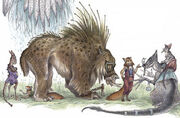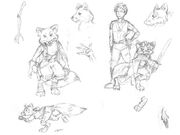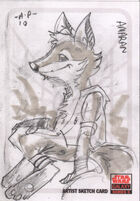What Is With The Boob Animal In Star Wars
![]()
![]()
The Amarans were a sentient species characterized past both vulpine and canine characteristics. The Amaran anatomy included pointed ears; a narrow, bewhiskered snout; a furry trunk; a bipedal opinion; and a bushy tail. As unrepentant hagglers, Amarans made natural traders, particularly of non-sentient beasts, which they tamed and bred.
Natives of the planet Amar, the Amarans became integrated into the galaxy by xv,000 BBY. Over time, Amarans emigrated to worlds such every bit Vulpter and Naboo. On the former planet, the vulpines served as managers of hugger-mugger storage facilities owned by the Trade Federation dare and staffed by workers drawn from the planet's native Vulptereen population. On Naboo, on the other hand, Amarans captured, tamed, and sold creatures such as the bursa.
Biology and appearance [ ]
The Amarans were a species of modest,[three] sentient bipeds[1] who were considered both vulpine[ii] and canine in nature. They had iv clawed digits per limb and walked digitigrade upon their toes. Each fellow member of the species had a bushy tail. The black eyes gazed frontwards, and a pointed cage held a reddish mouth and narrowed to a small, blackness nose[1] surrounded past whiskers.[4] 2 big, pointed ears stood cock at the top of the caput.[two]
Each Amaran was covered in variegated fur. One possible blueprint paired reddish-orangish fur across the dorsum, tail, and outside of the artillery and legs with white patches on the insides of the limbs and ears, on the snout, on the soles of the feet, and across the neck and belly. The fur grew short on most of the body with the exceptions of the tail and of tufted jowls.[two]
Society and civilization [ ]
Amarans were well-known for their propensity to bargain and bicker over transactions.[i] Some Amarans were known every bit beast charmers; a typical member of the profession might conduct a staff in the course of his or her duties.[four] The species wore clothing items such every bit trousers, vests, shirts,[two] earrings, and necklaces.[4]
History [ ]
The Amarans evolved on the planet Amar.[ane] The world became integrated into the greater galaxy at some signal between 25,000 and 15,000 BBY,[v] when it became role of the Airon sector, located in the Inner Rim[half dozen] portion of the Slice.[7] The planet remained part of space controlled by the Galactic Republic during the Jedi Civil State of war of 3959 to 3956 BBY,[eight] the Mandalorian Wars of 3976 to 3960 BBY,[9] and the Clone Wars[10] of 22 to xix BBY.[11] Years afterwards, in 137 ABY, the Amaran homeworld had fallen into space considered role of the Sith Lord Darth Krayt's Galactic Empire.[12]
Amarans in the milky way [ ]

Amaran beast dealers operated on planets ranging from Naboo to Coruscant.
Amar's location in the Stenness Node afforded the species access to the aboriginal hyperspace terminal that traveled through information technology.[thirteen] [14] By the time of the Clone Wars, Amarans had begun emigrating from Amar to other worlds. During the flow in which the planet Vulpter was nether Trade Federation command, six percent of the earth's 421 million inhabitants—or 25.iii million individuals—were members of the Amaran species. The management staff of Trade Federation–owned underground storage tunnels on the planet was drawn entirely from Vulpter's Amaran population; the facilities were otherwise staffed by the planet's native species, the Vulptereens. The arrangement caused tension between the two species, since the Vulptereen laborers felt they were ill compensated for their hard labor in the subterranean locales.[15]
During the government of the New Republic, some Amarans had established themselves in the Gungan Swamp on the planet Naboo. There, the Amarans captured wild bursas for breeding and off-world sales.[2] They plied this trade on the planet Coruscant likewise, with Amaran dealers constituting a major segment of the Coruscant Livestock Substitution and Exhibition, where they were known to have a wide selection of hard-to-find creatures.[3] One such dealer negotiated with a Pacithhip who was interested in reselling a bursa to Hutts; meanwhile, a smaller Amaran spoke with a Veknoid.[ii]
Behind the scenes [ ]
- "Seeing as there is canon defective, please feel free to use these ideas in your roleplaying game sessions every bit jump starters…."
- ―Robin Pronovost, on their unofficial take on the Amaran species

Robin Pronovost'southward concept art of the Amarans served as the inspiration for Terryl Whitlatch's version of the species.
Author and illustrator Robin Pronovost designed the Amarans for a work known as The Essential Guide to Episode I at the request of its author, Daniel Wallace.[17] Although The Essential Guide to Episode I was ultimately canceled, artist Terryl Whitlatch used the concept art created by Pronovost every bit inspiration for Amaran characters they included in illustrations for The Wildlife of Star Wars: A Field Guide, which was published by Chronicle Books in 2001.[sixteen]
Some confusion has surrounded the name of the Amarans' homeworld. The article "The Academy of Sanbra Guide to Intelligent Life: The Marvel Serial," published in Star Wars Gamer 1 in 2000, mentions a planet named "Amara" but otherwise makes no mention of the Amaran species.[13] Even so, the 2008 reference work The Complete Star Wars Encyclopedia includes an entry on the species, which names their homeworld "Amar."[1] 2009's The Essential Atlas, for its role, provides a cartographic placement for the Amar organisation, seemingly confirming the spelling "Amar" equally right.[xviii] Indeed, a forum posting by Daniel Wallace that same year confirms the fact that "Amara" and "Amar" refer to the same earth. This commodity follows the latter spelling, since it is the most electric current.[14]
On Jan 31, 2010, Pronovost presented their personal clarification of the Amarans—with the caveat that the ideas were not-canon until used in a licensed source—for the use of Star Wars fans who wished to add such characters to their role-playing scenarios. According to Pronovost, members of the species were relatively diminutive, continuing between iii.v and iv feet in meridian. Each Amaran tended toward a wiry frame, and his or her long tail acted as a counterweight that afforded groovy dexterity. The species'south fur came in colors as diverse equally white, orange, black, xanthous-orange, and gray, with white and grayness the almost common. Their eyes, meanwhile, were generally blackness, although greenish, blueish, and red were also known. Male Amarans tended to be slightly larger than females. Amaran mothers generally bore one pup at a time; just when breast-feeding young did female Amarans exhibit obvious breasts. An Amaran was considered an adult at age eighteen.[xvi]

Pronovost included Amarans in their sketch cards for 2010 Topps Star Wars Milky way Series 5.
Pronovost's ideas about Amaran lodge and civilization state that Amaran religion revered the stars and other celestial objects, such as their world'south moon, Rurrri. An Amaran myth told of Rurrri being lonesome and venturing to Amar in the form of a white fox. He cried all night, so the sun, Surru, manifested equally a gilt-furred Amaran to keep Rurrri visitor. The 2 mated, and their offspring became the stars. The species that evolved tended toward frivolity and canniness, traits they put to piece of work in careers such as trading, flying vehicles, and conning unsuspecting targets. They were naturally comfortable with non-sentient animals, and the species was known for its animal handlers. The earth's beast-tamers were able to capture and tame even large creatures, including the Vrrryyyk, a flying beast with both bird and reptile characteristics that served as the preferred Amaran means of transportation. They had a love for expensive food, beverage, and habiliment. The species maintained their tails in top order through grooming, equally the tail was a source of pride.[16]
The Amarans, co-ordinate to Pronovost, took corking pains to preserve the natural environment of their homeworld, a planet that abounded with life; in Amaran culture, poaching was considered a heinous law-breaking. Members of the species congregated in cities. Mining was a large manufacture on Amar, but the Amarans were careful to conduct such operations through non-destructive ways whenever possible. Amar's exports included artwork, foodstuffs, creatures, ores, fabric, and energy crystals.[16]
Pronovost's notes explain that reverence for the stars prompted the Amarans to develop a archaic class of hyperspace travel on their own. With the advance, they discovered the planet Naboo, a world that served as their gateway to the larger galactic customs. Amarans who emigrated from their homeworld oftentimes served as merchants, confidence people, gamblers, and tourists. A large population of Amarans moved to Naboo, where they sold local tamed creatures to offworlders also as the planet's natives, the Man Naboo, and the not-Human Gungans. The Amarans of Naboo grew wealthy from their swamp settlements and even saved the Naboo bursa from extinction at the hands of Gungan hunters. Some Amarans exhibited Force-sensitivity, but only a few became Jedi due to the foreignness of the discipline required past the Jedi Order; accordingly, Amaran Jedi were seen as odd by their not-Jedi fellows.[xvi]
Pronovost included Amaran characters in their creative person sketch cards for 2010 Topps Star Wars Galaxy Series 5, which was published by Topps in 2010.[4]
Sources [ ]
Notes and references [ ]
- ↑ ane.0 1.one 1.2 i.iii 1.four 1.5 i.half dozen i.7 The Complete Star Wars Encyclopedia, Vol. I, p. 26 ("Amaran").
- ↑ two.0 2.ane 2.2 2.3 two.4 two.five two.6 2.7 2.eight two.nine The Wild fauna of Star Wars: A Field Guide, p. 173.
- ↑ 3.0 iii.i 3.ii Coruscant and the Cadre Worlds, p. 15.
- ↑ four.0 4.ane four.2 four.iii
2010 Topps Star Wars Milky way Series 5 – Artist Sketch Cards past Robin Pronovost
- ↑ The Essential Atlas, p. 120.
- ↑
 Star Wars: The Essential Atlas Online Companion on StarWars.com (article) (backup link) .
Star Wars: The Essential Atlas Online Companion on StarWars.com (article) (backup link) . - ↑ The Essential Atlas, p. 36.
- ↑ The Essential Atlas, p. 130.
- ↑ The Essential Atlas, p. 132.
- ↑ The Essential Atlas, p. 151.
- ↑ The New Essential Chronology, pp. 51–84.
- ↑ The Essential Atlas, p. 226.
- ↑ 13.0 thirteen.1
 "The University of Sanbra Guide to Intelligent Life: The Marvel Series"—Star Wars Gamer 1, p. 67.
"The University of Sanbra Guide to Intelligent Life: The Marvel Series"—Star Wars Gamer 1, p. 67. - ↑ 14.0 14.1 The Essential Atlas and Galactic Cartography: Official Discussion on the Jedi Council Forums (Literature lath; posted by Dan Wallace on August 26, 2009, 10:09/10:11am; accessed October 29, 2011) (backup link)
- ↑
 "Byss and the Deep Core Part 4" on Wizards.com (original article link, content now obsolete; backup link) , p. 4.
"Byss and the Deep Core Part 4" on Wizards.com (original article link, content now obsolete; backup link) , p. 4. - ↑ 16.0 16.1 16.ii sixteen.3 16.four 16.5 Robin Pronovost: Amarans Backstory and History (2010-01-31). Art by Robin Pronovost. Archived from the original on January 23, 2021.
- ↑
 "Lostwords: The Essential Guide to Episode I" – Continuity, Criticisms, and Helm Panaka, Daniel Wallace's StarWars.com Blog (content now obsolete; archived from the original) .
"Lostwords: The Essential Guide to Episode I" – Continuity, Criticisms, and Helm Panaka, Daniel Wallace's StarWars.com Blog (content now obsolete; archived from the original) . - ↑ The Essential Atlas, p. 228.
Source: https://starwars.fandom.com/wiki/Amaran
Posted by: kiddmembech.blogspot.com

0 Response to "What Is With The Boob Animal In Star Wars"
Post a Comment